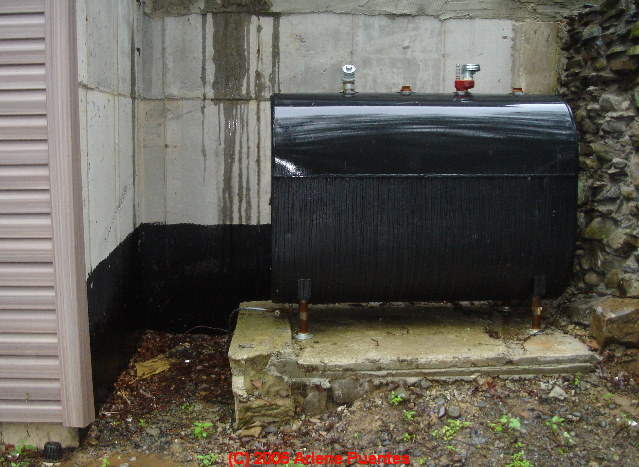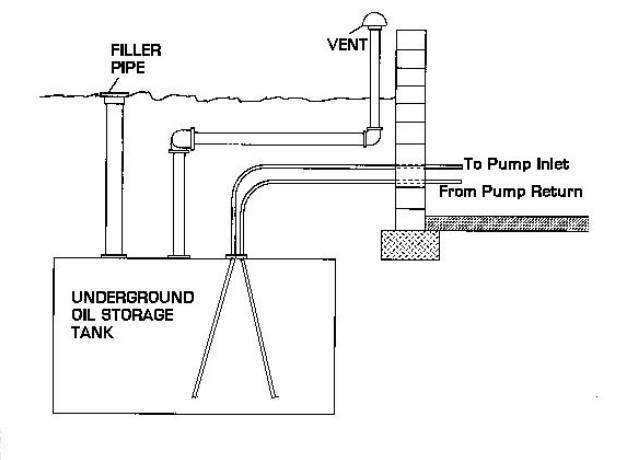 Heating Oil Tank & Piping Sludge Prevention or Cures
Heating Oil Tank & Piping Sludge Prevention or Cures
Part 4: Oil piping changes to avoid sludge or water problems
Use the Sculy Snorkel to Avoid Picking up Sludge in the OIl Tank
- POST a QUESTION or COMMENT about heating oil tank sludge, clogs, and relating heating equipment malfunctions
Sludge & crud or contaminants in heating oil storage tanks: installing a Scully Snorkel® to avoid picking up oil tank sludge & water and other oil piping changes, some simple & inexpensive, can often solve a problem with oil storage tank sludge, debris, water & clogging that otherwise leads to loss of heat.
This article series explains the causes and cures for heating system problems due to sludge in home heating oil tanks, including problems of clogged oil piping, clogged oil filters, oil burner malfunctions, and loss of heat due to sludge in the oil tank.
We explain why sludge is a problem in home heating oil & why it leads to loss of heat.
InspectAPedia tolerates no conflicts of interest. We have no relationship with advertisers, products, or services discussed at this website.
- Daniel Friedman, Publisher/Editor/Author - See WHO ARE WE?
Scully Snorkel or Piping Changes Leave Oil Tank Sludge Harmless at the Oil Tank Bottom

Install a Scully Snorkel at the oil tank. Scully Signal Co. produces a line of MagneLink™ Snorkel® Gauges - oil tank level indicators that include a floating oil-burner feed line fuel pickup.
The "Scully Snorkel" as it's popularly called among oil heat folks, incorporates a floating heating oil pick-up that uses a float to pick up oil from one inch below the surface of oil in the heating oil storage tank. [16]
By picking up heating oil just below the surface in the oil tank we avoid picking up sludge or water that - if present - will be at the bottom of the oil tank.
Incidentally, the Scully Snorkel gauge and oil pickup assembly can communicate with Scully's IntelliTank™ electronic automatic fuel recorder system.
- Scully Signal Company, 70 Industrial Way, Wilmington MA 01887, Tel: 800-272-8559, email: sales@scully.com, website: scully.com
Illustration of a Scully Snorkel gauge and heating oil pickup, courtesy Scully Signal Co. (permission req. 2013.) More details are about this and other oil tank gauges are
Change oil tank piping pick-up taken off of the bottom of the oil storage tank to enter the tank from a fitting at the tank top. Close off the piping at the oil tank bottom.
Some heating oil piping techs just close the service valve at the tank bottom and remove the piping.
I'd also install a cap on the valve outlet to assure that the valve can't just feed oil to the building floor.

A new oil supply line (or pair of lines if it's a two-pipe system) are routed from the top of the oil tank.
Inside the oil tank the pick-up line is not dropped all the way to the tank bottom. rather the line is kept 4-6" off of the tank bottom to avoid picking up water or sludge.
Watch out: when re-routing oil tank piping from tank bottom to connect through oil tank top, check the total lift required against the capacity of the oil burner fuel unit.
...
Continue reading at STEAM CLEANING OIL TANKS & OIL PIPING or select a topic from the closely-related articles below, or see the complete ARTICLE INDEX.
Or see these
Recommended Articles
- HEATING OIL CLOUD WAX GEL POINT
- OIL TANK SLUDGE
- OIL TANK REPLACE due to SLUDGE?
- OIL TANK TREATMENTS, ADDITIVES
- OIL TANK WATER REMOVAL
- SCULLY SNORKEL® or OIL PIPING CHANGES to AVOID SLUDGE
- STEAM CLEANING OIL TANKS & OIL PIPING
Suggested citation for this web page
SCULLY SNORKEL® or OIL PIPING CHANGES to AVOID SLUDGE at InspectApedia.com - online encyclopedia of building & environmental inspection, testing, diagnosis, repair, & problem prevention advice.
Or see this
INDEX to RELATED ARTICLES: ARTICLE INDEX to HEATING OIL, OIL BURNERS, OIL FIRED HEATERS, OIL TANKS
Or use the SEARCH BOX found below to Ask a Question or Search InspectApedia
Ask a Question or Search InspectApedia
Try the search box just below, or if you prefer, post a question or comment in the Comments box below and we will respond promptly.
Search the InspectApedia website
Note: appearance of your Comment below may be delayed: if your comment contains an image, photograph, web link, or text that looks to the software as if it might be a web link, your posting will appear after it has been approved by a moderator. Apologies for the delay.
Only one image can be added per comment but you can post as many comments, and therefore images, as you like.
You will not receive a notification when a response to your question has been posted.
Please bookmark this page to make it easy for you to check back for our response.
IF above you see "Comment Form is loading comments..." then COMMENT BOX - countable.ca / bawkbox.com IS NOT WORKING.
In any case you are welcome to send an email directly to us at InspectApedia.com at editor@inspectApedia.com
We'll reply to you directly. Please help us help you by noting, in your email, the URL of the InspectApedia page where you wanted to comment.
Citations & References
In addition to any citations in the article above, a full list is available on request.
- [2] Domestic and Commercial Oil Burners, Charles H. Burkhardt, McGraw Hill Book Company, New York 3rd Ed 1969.
- [10] "Warm Air Heating Systems". Instructional Technologies Institute, Inc., 145 "D" Grassy Plain St., Bethel, CT 06801 800/227-1663 [home inspection training material] 1987
- [10] Heating, Ventilating, and Air Conditioning Volume I, Heating Fundamentals, Boilers, Boiler Conversions, James E. Brumbaugh, ISBN 0-672-23389-4 (v. 1) Volume II, Oil, Gas, and Coal Burners, Controls, Ducts, Piping, Valves, James E. Brumbaugh, ISBN 0-672-23390-7 (v. 2) Volume III, Radiant Heating, Water Heaters, Ventilation, Air Conditioning, Heat Pumps, Air Cleaners, James E. Brumbaugh, ISBN 0-672-23383-5 (v. 3) or ISBN 0-672-23380-0 (set) Special Sales Director, Macmillan Publishing Co., 866 Third Ave., New York, NY 10022. Macmillan Publishing Co., NY
- [13] Installation Guide #200, The Hydronics Institute, 35 Russo Place, Berkeley Heights, NJ 07922
- [14] The ABC's of Retention Head Oil Burners, National Association of Oil Heat Service Managers, TM 115, National Old Timers' Association of the Energy Industry, PO Box 168, Mineola, NY 11501. (Excellent tips on spotting problems on oil-fired heating equipment. Booklet.
- [15] AGA, Redfyre, or Rayburn directly at AGA, Station Road, Ketley, Telford, Shropshire, TF1 5AQ, UK, Tel: 08457 626 147, or 08458 152 020, Website: rayburn-web.co.uk
- [16] "Scully Oil Delivery Systems", Scully Signal Company, 70 Industrial Way, Wilmington MA 01887, Tel: 800-272-8559, email: sales@scully.com, website: scully.com, retrieved 3/14/13, copy on file as Scully_Delivery Systems Catalogue.pdf.
- [17] William K. Rashbaum, "Heating Oil Companies Face Inquiry on Purity of Fuel", The New York Times, 21 March 2013 p. A22.
- In addition to citations & references found in this article, see the research citations given at the end of the related articles found at our suggested
CONTINUE READING or RECOMMENDED ARTICLES.
- Carson, Dunlop & Associates Ltd., 120 Carlton Street Suite 407, Toronto ON M5A 4K2. Tel: (416) 964-9415 1-800-268-7070 Email: info@carsondunlop.com. Alan Carson is a past president of ASHI, the American Society of Home Inspectors.
Thanks to Alan Carson and Bob Dunlop, for permission for InspectAPedia to use text excerpts from The HOME REFERENCE BOOK - the Encyclopedia of Homes and to use illustrations from The ILLUSTRATED HOME .
Carson Dunlop Associates provides extensive home inspection education and report writing material. In gratitude we provide links to tsome Carson Dunlop Associates products and services.


